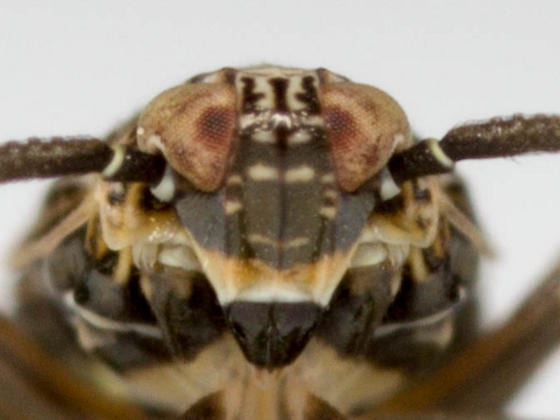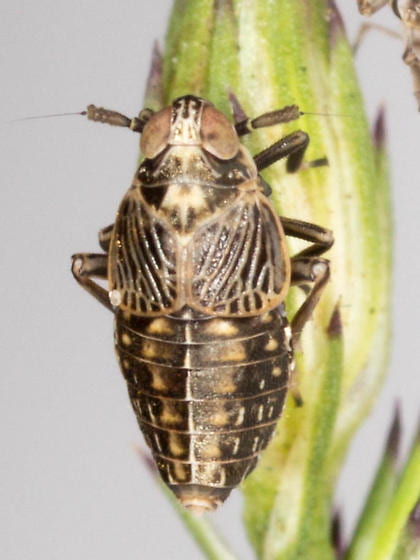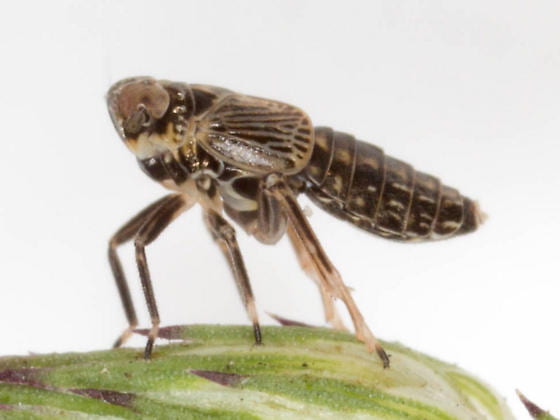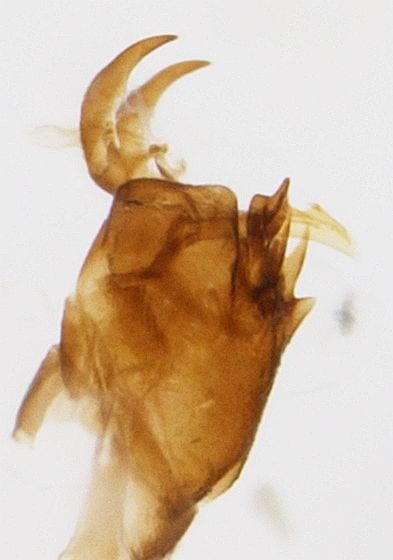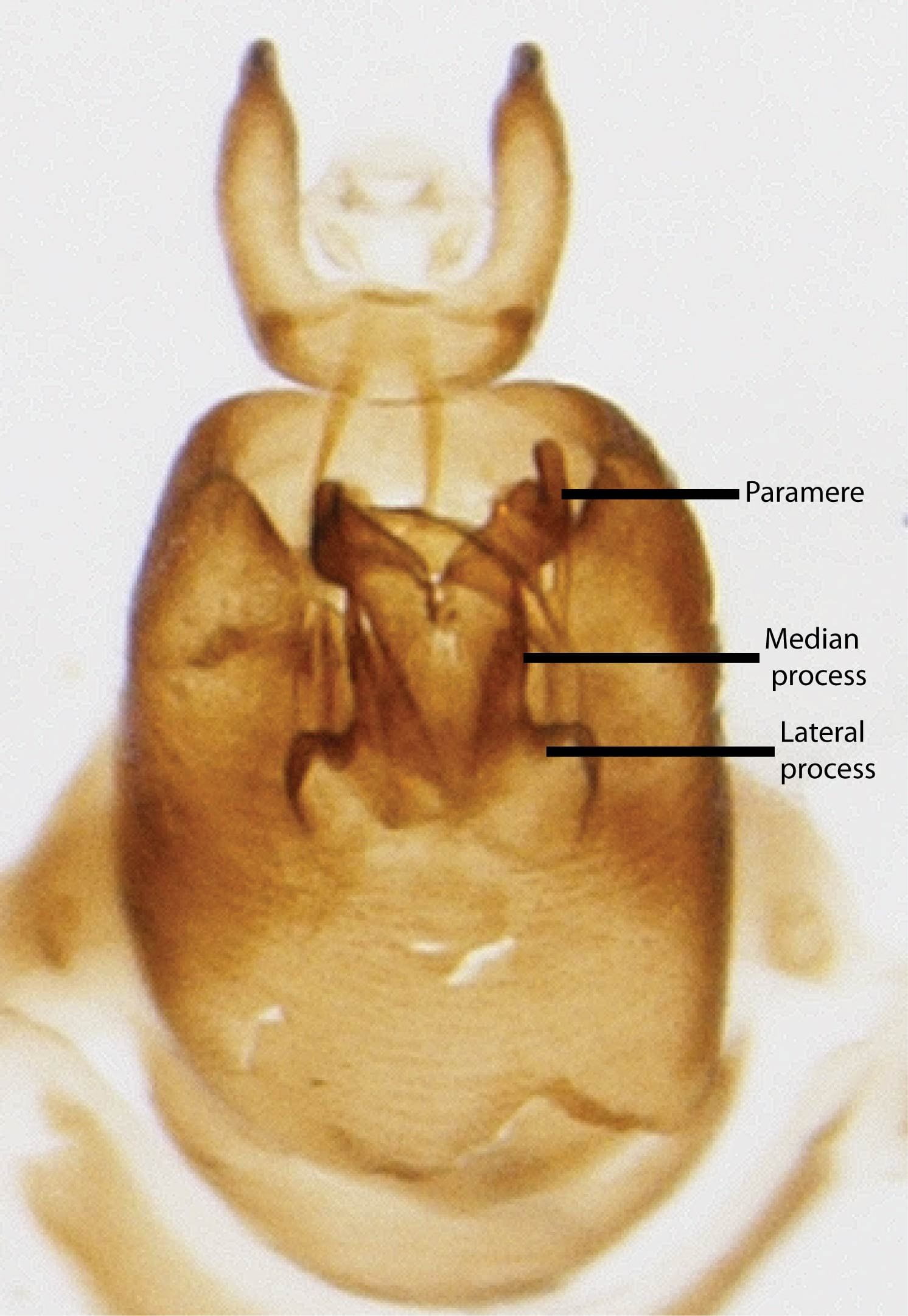[Back to Higher classification of Delphacidae]
Contents
Family Delphacidae Leach, 1815
Subfamily Delphacinae Leach, 1815
Tribe Delphacini Leach, 1815
Genus Pissonotus Van Duzee, 1897: 236.
Generic synonym:
= Phyllodictus Ball, 1926: 18-19 (Type species Phyllodictus tessellatus Ball, 1926); syn. by Morgan and Beamer, 1949: 97; Bartlett and Deitz, 2000: 13).
Type species: Pissonotus marginatus Van Duzee, 1897: 236.
Distribution
Widespread in North America with a few species in the Caribbean and Neotropics.
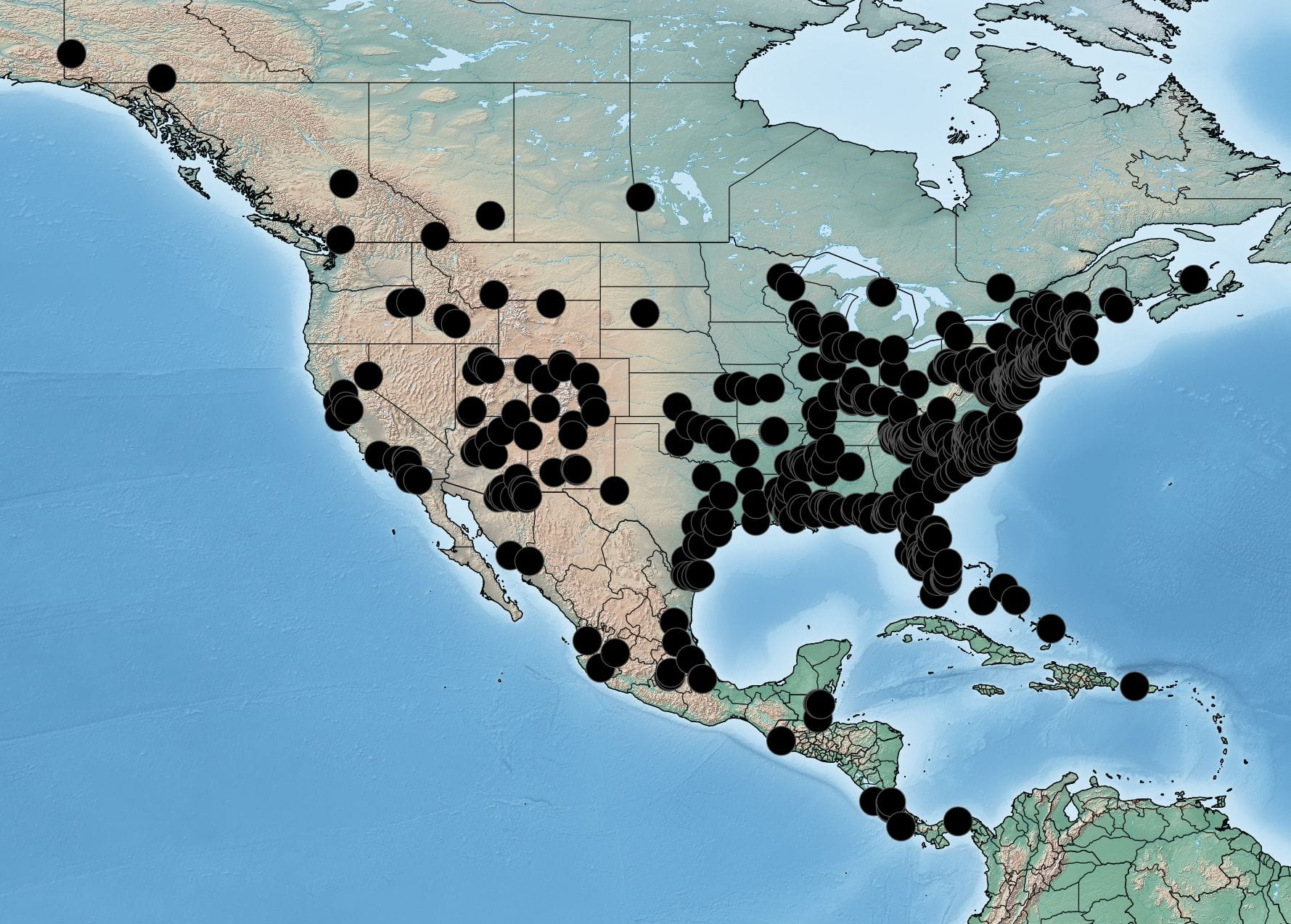
Distribution of ~2,700 specimens of Pissonotus (Neotropics truncated) from Tri Trophic thematic collection network.
Recognized species
43 currently recognized species plus 4 species of uncertain status as follows
Recognized species
1 Pissonotus abdominalis (Crawford, 1914) – Belize, Costa Rica, Dominican Republic, Honduras, Mexico (Sinaloa, Nayarit, Morelos, Oaxaca, Chiapas); Nicaragua.
= Dicranotropis bakeri abdominalis Crawford, 1914.
= Pissonotus abdominalis (Crawford, 1914); comb. by Bartlett and Deitz, 2000: 102.
2 Pissonotus agrestis Morgan and Beamer, 1949 – USA: Florida, Georgia (Connecticut reported, but probably mislabelled specimen).
3 Pissonotus albivultus Morgan and Beamer, 1949 – USA: Florida, Louisiana, ? Texas; Belize, Costa Rica, Guatemala, Honduras, Mexico (San Luis Potosí, Vera Cruz, Hidalgo, Oaxaca, ?Chiapas); Nicaragua, ?Venezuela.
4 Pissonotus albovenosus Osborn, 1935 – Throughout eastern USA, especially south; Bahamas (Cat); Dominican Republic, Jamaica, Mexico, Puerto Rico.
5 Pissonotus aphidioides Van Duzee, 1897: 239 – USA: Connecticut, Georgia, Iowa, Illinois, Maryland, Michigan, North Carolina, New Jersey, New York, Pennsylvania; Canada: Alberta, Manitoba, Ontario, ?Prince Edward Island, Quebec
= Pissonotus aphidioides Van Duzee, 1897: 236, 239.
= Pissonotus aphidiodes Van Duzee, 1897; missp. by Oman 1947: 216.
= Pissonotus aphidoides Van Duzee, 1897; missp. by Strickland 1940: 88.
= Pissonotus (Phyllodictus) aphidioides Van Duzee, 1897; comb. by Morgan & Beamer 1949: 101.
6 Pissonotus aquilonius Morgan and Beamer, 1949 – USA: Wisconsin.
= Pissonotus aguilonius Morgan & Beamer, 1949: 125-126; missp. by Wilson & McPherson 1980b.
7 Pissonotus basalis Van Duzee, 1897: 238 – Connecticut, ?Idaho, Illinois, Indiana, Maine, Michigan, Nebraska, New Hampshire, New Jersey, New York, Ohio, Pennsylvania, Vermont, Wisconsin; Canada: ?Alberta, Manitoba, New Brunswick, Nova Scotia, Ontario, Quebec.
= Pissonotus basalis Van Duzee 1897: 227, 238-239; Bartlett & Deitz 2000: 95.
= Pissonotus (Phyllodictus) basalis Van Duzee 1897; status by Morgan & Beamer 1949: 108.
= Pissonotus crawfordi Metcalf, 1923; syn. by Morgan & Beamer 1949: 108-109.
8 Pissonotus binotatus Spooner, 1912 – USA: Alabama, Arkansas, Delaware, Florida, Georgia, Louisiana, Mississippi, Missouri, North Carolina, Tennessee, Texas, Virginia; Bermuda
= Pissonotus binotatus Spooner, 1912: 239.
= Dicranotropis binotatus (Spooner, 1912); comb. by Crawford 1914: 601; returned to Pissonotus by Van Duzee 1916a: 83.
9 Pissonotus boliviensis Bartlett, 2000 – Bolivia (Santa Cruz, La Paz, Cochabamba); Brazil (Mato Grosso, Rio de Janeiro, Rondonia); Uruguay, Argentina (Tucuman, Chaco, Corrientes).
10 Pissonotus brevistilus Bartlett, 2000 – Mexico (Nayarit).
11 Pissonotus brunneus Van Duzee, 1897: 239 – USA: Alabama, Arkansas, Connecticut, Delaware, District of Columbia, Florida, Georgia, Iowa, Illinois, Indiana, Kansas, Kentucky, Louisiana, Massachusetts, Maryland, Michigan, Mississippi, Missouri, North Carolina, New Hampshire, New Jersey, New York, Ohio, Oklahoma, Pennsylvania, South Carolina, Tennessee, Texas, Virginia, Wisconsin, West Virginia; Canada: Nova Scotia, Ontario, Quebec, Alberta; Mexico (San Lois Potosí, Vera Cruz, Hidalgo, Michoacán, Puebla, Chiapas). “Jamaica” record in error; specimen label referred to Jamaica on Long Island in New York.
= Pissonotus brunneus Van Duzee, 1897: 236, 239-240.
= Pissonotus divaricatus Spooner, 1912: 236.
= Dicranotropis divaricatus (Spooner, 1912); comb. by Crawford 1914: 600.
= Dicranotropis brunneus (Van Duzee, 1897); comb. by Crawford 1914: 594, 599; returned to Pissonotus by Metcalf 1915: 44.
= Pissonotus divaricatus Spooner, 1912; syn. by Morgan & Beamer 1949: 115-117.
12 Pissonotus canadensis Bartlett, 2000 – CAN: Alberta, Manitoba, Ontario.
13 Pissonotus concolor Bartlett, 2000 – USA: Connecticut?, Massachusetts?, North Carolina, New York.
14 Pissonotus decussatus Bartlett, 2000. – Mexico (Chiapas); Guatemala.
15 Pissonotus delicatus Van Duzee, 1897: 237 – Widespread in western United states with occasional eastern records; also Canada: Alberta, British Columbia, Saskatchewan, Quebec; Mexico (Baja California Norte, Coahuila, Tamaulipas), ?Jamaica.
= Pissonotus delicatus Van Duzee, 1897: 237-238.
= Pissonotus delicatus delicatus Van Duzee, 1897; subspecific status implied by description of P. d. melanurus Van Duzee, 1917a.
= Pissonotus pallipes Van Duzee, 1897: 238-239; syn. by Oman 1947: 217-218, 220.
= Dicranotropis delicatus (Van Duzee, 1897); comb. by Crawford 1914: 594, 596-597.
= Dicranotropis pallipes (Van Duzee, 1897); comb. by Crawford 1914: 594, 599.
= Pissonotus giffardi Van Duzee, 1925: 407-408: syn. by Morgan & Beamer 1949: 134-135.
16 Pissonotus dentatus Morgan and Beamer, 1949 – USA: Florida, Illinois, North Carolina; Cuba (Illinois and North Carolina records may be mislabeled specimens).
17 Pissonotus divergens Bartlett, 2000 – USA: ?Arizona, ?Colorado, Kansas, New Mexico, ?Texas; to my surprise, recently found in Maryland and Delaware.
18 Pissonotus dorsalis Van Duzee, 1897: 239 – USA: Connecticut, Massachusetts, Maryland, Maine, Michigan, Minnesota, North Carolina, New Hampshire, New York, Ohio, Pennsylvania, Wisconsin; Canada: Manitoba, Ontario, Quebec, Prince Edward Island, Nova Scotia, Newfoundland, New Brunswick.
19 Pissonotus festucae Bartlett, 2000 – USA: ?Arizona; Mexico (Federal District, Jalisco); ?Puerto Rico.
20 Pissonotus flabellatus (Ball, 1903) – Alabama, Arkansas, Connecticut, District of Columbia, Delaware, Florida, Georgia, Illinois, Indiana, Kansas, Kentucky, Massachusetts, Maryland, Missouri, Mississippi, North Carolina, New York, Ohio, Pennsylvania, Tennessee, Texas, Virginia, West Virginia; Canada: Ontario.
= Phyllodinus flabellatus Ball, 1903: 232.
= Phyllodictus flabellatus (Ball, 1903); comb. by Ball 1926: 19.
= Pissonotus (Phyllodictus) flabellatus (Ball, 1903); comb. by Morgan & Beamer 1949: 103-105.
= Pissonotus flabellatus (Ball, 1903); status by Bartlett & Deitz 2000: 53.
= Phyllodinus koebelei Osborn, 1903a: 44-45; syn. by Metcalf 1923: 148.
= Phyllodinus fuscous Osborn, 1903a: 46; syn. by Ball 1926: 19-20.
21 Pissonotus frontalis (Crawford, 1914) – USA: Oregon, California; Canada: British Columbia.
= Pissonotus exiguus Morgan & Beamer, 1949; syn. by Bartlett & Deitz 2000: 44-46.
22 Pissonotus guttatus Spooner, 1912 – USA :Alabama, Arkansas, Colorado, Connecticut, District of Columbia, Florida, Iowa, Illinois, Indiana, Kansas, Louisiana, Maryland, Maine, Michigan, Minnesota, North Carolina, New Hampshire, New York, Ohio, Pennsylvania, Tennessee, Virginia, Wisconsin; Canada: Manitoba, Saskatchewan, Ontario, Quebec, Nova Scotia,
23 Pissonotus jamaicensis Bartlett, 2000 – Jamaica.
24 Pissonotus lactofascius Morgan and Beamer, 1949 – USA: Arizona, Colorado, New Mexico, Wyoming.
25 Pissonotus marginatus Van Duzee, 1897: 236 – USA: Arkansas, Connecticut, District of Columbia, Florida, Georgia, Iowa, Illinois, Indiana, Kansas, Kentucky, Louisiana, Maryland, Michigan, Missouri, Mississippi, North Carolina, New Hampshire, New Jersey, New York, Ohio, Pennsylvania, Tennessee, Virginia, Vermont, Wisconsin, West Virginia; Canada: Manitoba, Ontario, Quebec.
= Pissonotus ater Van Duzee 1897: 237; syn. by Morgan & Beamer 1949: 134-135.
26 Pissonotus melanurus Van Duzee, 1917a – USA: California.
= Pissonotus delicatus melanurus Van Duzee, 1917a: 311-312.
= Pissonotus melanurus Van Duzee, 1917a; status by Bartlett & Deitz 2000: 143-144.
27 Pissonotus merides Morgan and Beamer, 1949 – USA: Alabama, Florida, Georgia, Mississippi, North Carolina.
28 Pissonotus minutus Beamer, 1952 – USA: Arizona.
29 Pissonotus muiri Metcalf, 1943 – Belize, Costa Rica, El Salvador, Guatemala, Honduras, Nicaragua, Panama; USA: FL (Halbert 2016).
= Megamelus albicollis Crawford, 1914 (nec Motschulsky, 1863).
= Pissonotus albicollis (Crawford, 1914): comb. by Muir and Giffard, 1924, 11.
= Pissonotus muiri Metcalf, 1943; new name for unavailable M. albicollis Crawford, 1914.
30 Pissonotus neotropicus (Muir, 1926) – Argentina (Misiones), Bolivia, Brazil (Mato Grosso, Parana), Ecuador, Guyana, Paraguay, Peru, Venezuela.
= Phyllodinus neotropicus Muir, 1926: 18-19.
= Phyllodictus neotropicus (Muir, 1926); comb. by Metcalf, 1943: 146.
= Pissonotus neotropicus (Muir, 1926); comb. by Bartlett & Deitz, 2000: 64-66.
31 Pissonotus niger Morgan and Beamer, 1949 – USA: Connecticut, Illinois, Michigan, North Carolina, New York, South Dakota, Virginia, ?Montana; Canada: Manitoba,
32 Pissonotus nigriculus Morgan and Beamer, 1949 – USA: Florida, Texas.
33 Pissonotus nitens (Van Duzee, 1909) – USA: Alabama, Florida, Mississippi; Jamaica
= Phyllodinus nitens Van Duzee, 1909: 198-199.
= Phyllodictus nitens (Van Duzee, 1909); comb. by Ball 1926: 20.
= Pissonotus (Phyllodictus) nitens (Van Duzee, 1909); comb. by Morgan & Beamer 1949: 100, 107-108.
= Pissonotus nitens (Van Duzee, 1909); status by Bartlett & Deitz 2000: 100.
34 Pissonotus paludosus Morgan and Beamer, 1949 – USA: Alabama, Florida, Georgia, Louisiana, Mississippi, North Carolina, South Carolina
35 Pissonotus paraguayensis Bartlett, 2000 – ?Bolivia, Brazil (Minas Gerais); Paraguay.
36 Pissonotus piceus (Van Duzee, 1894) – Widespread in eastern and central US; including Canada: Ontario; Belize, Bermuda, Costa Rica, Cuba, Honduras, Jamaica, Mexico (Sinaloa, Vera Cruz, San Luis Potosí, Jalisco), Nicaragua, Panama, Peru, Trinidad, Venezuela (Guarico).
= Megamelus piceus Van Duzee, 1894b: 28.
= Pissonotus piceus (Van Duzee, 1894b); comb. by Oman 1947: 219-220.
= Pissonotus fulvus Metcalf, 1923: 206; syn. by Morgan & Beamer 1949: 137.
= Dicranotropis bakeri Crawford, 1914: 598; syn. by Bartlett & Deitz 2000: 107-116.
= Delphacodes pictifrons Osborn, 1938: 344; syn. by Bartlett & Deitz 2000: 107.
37 Pissonotus quadripustulatus (Van Duzee, 1909) – USA: Alabama, Florida, Georgia, Louisiana, Texas; Mexico (Tamaulipas).
= Stobaera 4-pustulata Van Duzee, 1909: 200.
= Pissonotus foveatus Spooner 1912: 235.
= Stobaera quadripustulata Van Duzee, 1909; transliteration of 4-pustulata by Crawford 1914: 572, 576.
= Dicranotropis foveatus (Spooner, 1912); comb. by Crawford 1914: 600.
= Dicranotropis variegatus (Spooner, 1912); comb. by Crawford 1914: 600.
= Pissonotus foveatus Spooner 1912; syn. by Van Duzee 1916a: 84.
= Stobaera foveatus (Spooner, 1912); comb. by Van Duzee 1916a: 84.
= Pissonotus quadripustulatus (Van Duzee, 1909); comb. by Metcalf 1923: 148, 170.
= Pissonotus variegatus Spooner, 1912; syn. by Metcalf 1923: 148.
= Pissonotus 4-pustulata (Van Duzee, 1909); comb. by Morgan & Beamer 1949: 110, 120-121.
= Pissonotus quadripustutatus (Van Duzee, 1909); missp. by Stiling 1994, noted by Bartlett & Deitz 2000: 34-38.
38 Pissonotus radiolus Bartlett, 2000 – Canada: Ontario
39 Pissonotus rubrilatus Morgan and Beamer, 1949 – USA: Colorado, Idaho, Montana, Wyoming; Canada: British Columbia,
40 Pissonotus spatulatus Bartlett, 2000 – USA: California; Mexico: Durango, Jalisco
Pissonotus speciosus Metcalf, 1923: 205; jr. syn of Flavoclypeus andromedus.
41 Pissonotus spooneri Morgan and Beamer, 1949 – USA: Connecticut, Florida, Missouri, New Hampshire, New York, Ohio, Pennsylvania.
= Pissonotus piceus Spooner, 1912: 238-239 (nec Van Duzee, 1894b).
= Phyllodictus flabellatus (Ball, 1903); syn. by Ball 1926: 19 (error).
= Pissonotus (Phyllodictus) spooneri Morgan & Beamer, 1949: 104-107; replacement name by Morgan & Beamer 1949: 104-107.
= Pissonotus spooneri Morgan & Beamer, 1949; status by Bartlett & Deitz 2000: 98.
42 Pissonotus tessellatus (Ball, 1926) – USA: Florida, Georgia, Mississippi, North Carolina, Ohio.
= Phyllodictus tessellatus Ball, 1926: 19.
= Pissonotus tessellatus (Ball, 1926); comb. by Morgan & Beamer 1949: 100.
43 Pissonotus tumidus Morgan and Beamer, 1949 – USA: Connecticut, Michigan, Minnesota, New Hampshire, New York, Pennsylvania, Virginia; Canada: Manitoba.
= Pissonotus (Phyllodictus) tumidus Morgan & Beamer, 1949: 102-103.
= Pissonotus tumidus Morgan & Beamer, 1949; status by Bartlett & Deitz 2000: 49.
Species of uncertain status (these species are not Pissonotus, but have not yet been placed in another genus)
Pissonotus absenta Caldwell, 1951 (in Caldwell & Martorell 1951) – Puerto Rico
Pissonotus haywardi Muir, 1929 – Argentina, Brazil
Pissonotus nigridorsum Metcalf, 1923: 206 – USA: Pennsylvania (now syn. of Flavoclypeus nitens)
Pissonotus substitua (Walker,1851) – Galapagos
Species formerly placed in Pissonotus
Pissonotus speciosus Metcalf, 1923: 205 is a jr syn of Flavoclypeus andromedus.
Pissonotus striolus Osborn, 1935: 247 is a jr syn of Euides fasciatella.
Pissonotus belemensis Muir, 1926b: 19; to Euides belemensis (Muir, 1926b); comb. by Bartlett & Deitz, 2000: 146.
Pissonotus brazilensis Muir, 1926b: 19; to Euides brazilensis (Muir, 1926b); comb. by Bartlett & Deitz, 2000: 146.
Pissonotus equadorensis Muir, 1926b: 19; to Euides equadorensis (Muir, 1926b); comb. by Bartlett & Deitz, 2000: 146.
Pissonotus megalostylus Muir, 1919: 36; to Euides megalostylus (Muir, 1919); comb. by Bartlett & Deitz, 2000: 146.
Pissonotus pylaon (Kirkaldy, 1907) to Terthron pylaon (Kirkaldy, by to Bartlett & Deitz (2000: 146).
Pissonotus nigridorsum Metcalf, 1923: 206; syn. with Flavoclypeus nitens (Muir & Giffard) by Bartlett et al. 2014: 114 [Delphacodes nitens used by Bartlett et al. (2014) to avoid homonymy with Delphacodes nigridorsum (Crawford, 1914), noted by Kennedy and Bartlett 2014: 33].
I am aware of several undescribed species in this genus.
Economic Importance
Limited. Reported from a variety of crops (i.e., Pissonotus piceus on celery, Pissonotus dorsalis on beet and carrot; Pissonotus albivultus on kidneybean), but these reports need confirmation and are are probably incidental.
Recorded hosts
Most species with confirmed hosts are recorded from plants in the Asteraceae with the exception of Pissonotus piceus on Polygonaceae.
Pissonotus abdominalis – Ageratina adenophora (Spreng.) R.M. King & H. Rob. (as Eupatorium adenophorum Spreng.) (Asteraceae).
Pissonotus albivultus – Eriobotrya japonica (Thunb.) Lindl. (loquat, Rosaceae) and Phaseolus vulgaris L. (kidneybean; Fabaceae) (neither of these seem likely as a primary host).
Pissonotus albovenosus – Iva frutescens L. (Jesuit’s bark); Lygodesmia grandiflora (Nutt.) Torr. & A. Gray (largeflower skeletonplant); Borrichia frutescens (L.) DC. (bushy seaside tansy) (Asteraceae).
Pissonotus aphidioides – Castilleja coccinea (L.) Spreng. (scarlet Indian paintbrush, Scrophalariaceae) (this host seems unlikely).
Pissonotus basalis – Grindelia squarrosa (Pursh) Dunal (curlycup gumweed; Asteraceae).
Pissonotus binotatus – Conyza canadensis (L.) Cronquist var. pusilla (Nutt.) Cronquist (Canadian horseweed; especially in well-drained situations were the plant perpetuates, less often in fallow fields), Eupatorium L. (thoroughwort) (Asteraceae).
Pissonotus boliviensis – Pontederia sp. (pickerelweed; Pontederiaceae).
Pissonotus brunneus – Erigeron quercifolius Lam. (oakleaf fleabane), Erigeron sp., Symphyotrichum puniceum (L.) A. Löve & D. Löve var. puniceum (purplestem aster; as Aster puniceus L.; Asteraceae); Lespedeza sp. (Fabaceae), Agrostis sp. (Poaceae).
Pissonotus delicatus – Grindelia squarrosa (Pursh) Dunal (Curlycup gumweed); Grindelia papposa G.L. Nesom & Suh (as Haplopappus ciliatus (Nutt.) DC.) (Spanish gold), Heterotheca subaxillaris (Lam.) Britton & Rusby (camphorweed: Asteraceae), Sphaeralcea angustifolia (Cav.) G. Don (as Sphaeralcea emoryi Torr. ex A. Gray) (copper globemallow; Malvaceae).
Pissonotus divergens – Artemisia vulgaris L. (common wormwood, Asteraceae), not published, but I now have a long series of this species from this plant.
Pissonotus dorsalis – Beta vulgaris L. (common beet; Chenopodiaceae ), Salix sp. (willow; Salicaceae), Agrostis sp. (bentgrass, Poaceae), Solidago sp. (goldenrod, Asteraceae), Daucus carota L. (Queen Anne’s Lace, Apiaceae).
Pissonotus festucae – Festuca amplissima Rupr. (Poaceae).
Pissonotus flabellatus – Mimosa L. as Schrankia (Fabaceae) (not a likely host).
Pissonotus frontalis – Artemisia furcata M. Bieb. var. heterophylla (Besser) Hultén (forked wormwood), Artemisia sp. (Asteraceae).
Pissonotus marginatus – Carex sp. (Cyperaceae), Solidago sp. (goldenrod; Asteraceae).
Pissonotus melanurus – Grindelia camporum Greene (great valley gumweed; Asteraceae).
Pissonotus muiri – Zexmenia pinetorum Standl. & Steyerm. (Asteraceae).
Pissonotus nitens – Helianthus sp. (Asteraceae).
Pissonotus paludosus – “On Cane”; (Arundinaria sp.?, Poaceae).
Pissonotus piceus (Van Duzee) – Polygonum hydropiperoides Michx. (Swamp smartweed), Polygonum sp., (Polygonaceae); Ludwigia peploides (Kunth) P.H. Raven (floating primrose-willow), Ludwigia grandiflora (Michx.) Greuter & Burdet (large-flower primrose-willow; as Ludwigia uruguayensis (Camb.) H. Hara; Onagraceae); Liquidambar styraciflua L. (sweetgum; Hamamelidaceae) (sweetgum is unlikely; this species can be abundant on swamp smartweed and may be on some closely related smartweeds).
Pissonotus quadripustulatus – Borrichia frutescens (L.) DC. (bushy seaside tansy; Asteraceae).
An undetermined Pissonotus nymph was photographed on Coreopsis tinctoria Nutt.
Hosts from Bartlett and Deitz (2000); plant names from USDA PLANTS or Tropicos.
Parasites/predators
Anagrus flaveolus Waterhouse (Mymaridae) – egg parasite of Pissonotus sp.
undetermined Dryinidae also [bugguide here] [it looks like Pissonotus concolor to me, not entirely sure]

Pissonotus maybe concolor with Dryinidae from Bugguide by MJ Hatfield (Iowa)
Recognition
Key to species of eastern and central US (modified from Bartlett & Deitz, 2000)
This genus was revised by Bartlett and Deitz (2000) and previously by Morgan and Beamer (1949). As the genus name suggests (Pissa– = pitch [colored], notum = back)], members of this genus tend to be chestnut colored, although they very from orange to nearly black (sometimes within a species, esp. Pissonotus delicatus, Pissonotus binotatus). Pissonotus piceus is often encountered at lights. The most commonly encountered species are Pissonotus piceus, P. delicatus, P. binotatus, P. albovenosus and P. brunneus. Other species may be locally common, but some are rarely encountered.
The color pattern (especially of brachypters) is helpful to recognize members of this genus. Most species are chestnut brown, with brachyptery more common than macroptery. Many species have a white band at the end of the tegmina (which leave several abdominal segments exposed), and also a white band on the trailing margin of the pronotum. The clypeus is often dark brown, contrasting with a pale band along the frontoclypeal suture (except P. nitens). A few species (the former genus Phyllodictus) have slightly to considerably expanded front tibiae (P. aphidioides, P. basalis, P. flabellatus, P. neotropicus, P. nitens, P. spooneri, and P. tumidus). Pissonotus quadripustulatus is unusual in being pale-bodied (straw-colored) and having flattened first antennal segments. The carinae of the frons are usually inconspicuous (except P. albivultus). The median carinae of the frons is forked on the frons, although the arms are closely approximated.
All species in the genus can be recognized by the presence of a pair of symmetrical processes on the ventral margin of the opening of the male pygofer. The presence of median processes on the opening of the pygofer is shared (among genera represented in North America) with Scolopygos (processes asymmetrical, uniform colored), Parkana (processes asymmetrical, overall features very different), and Perkinsiella (larger. antennae flattened).
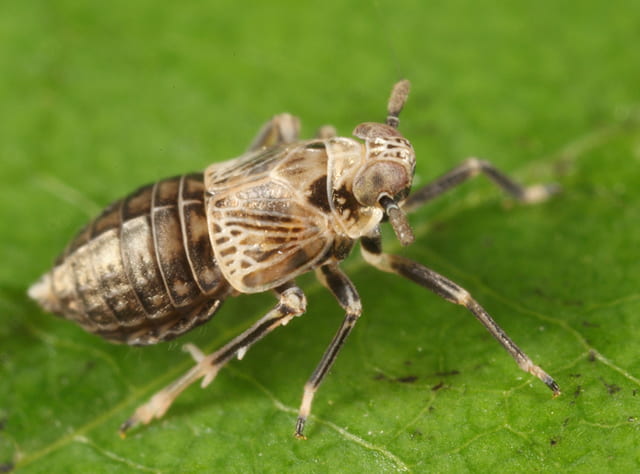
Pissonotus albovenosus by Tom Murray from Discover Life.
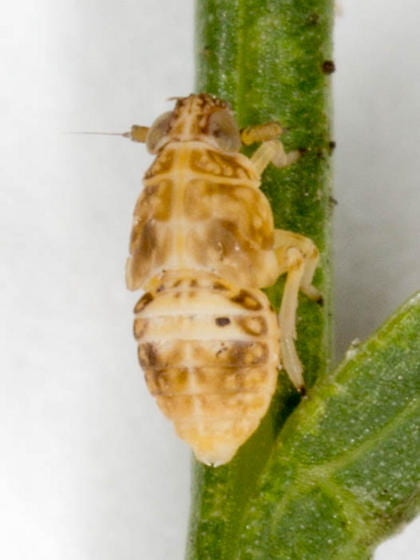
Pissonotus albovenosus nymph Houston, Harris County, Texas by John Schneider on Bugguide (can’t vouch for the ID but he has adults also)
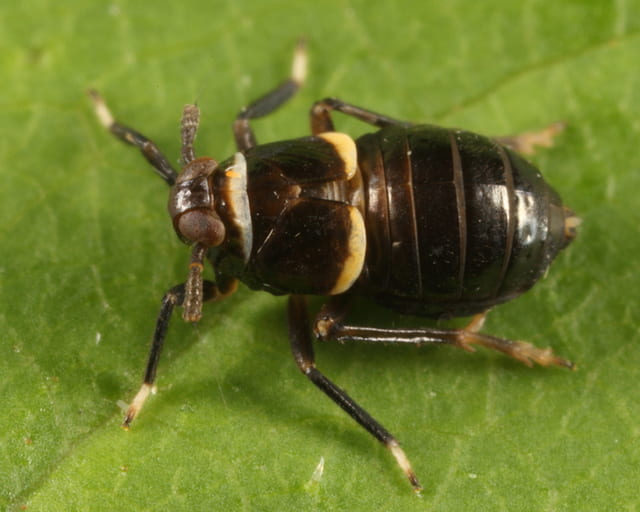
Pissonotus basalis, by Tom Murray on Discover Life.
Pissonotus binotatus (specimens may also be dark; not dark marking on anterior of antennae – this is also found on delicatus; mostly, binotatus is eastern and delicatus not on the east coast, except strays; binotatus mostly on Conzya where the plant persists – i.e., not successional fields, but roadsides and sandy areas)
Pissonotus brunneus
(pale wing veins on the brachypter, without spots on the face; a common species but usually not taken in long series)
Pissonotus delicatus (very similar to binotatus; generally, binotatus is eastern and delicatus western, but delicatus can occur in the east, especially along the gulf coast; best separated from binotatus based on genitalia – most easily by the median processes of delicatus being short)
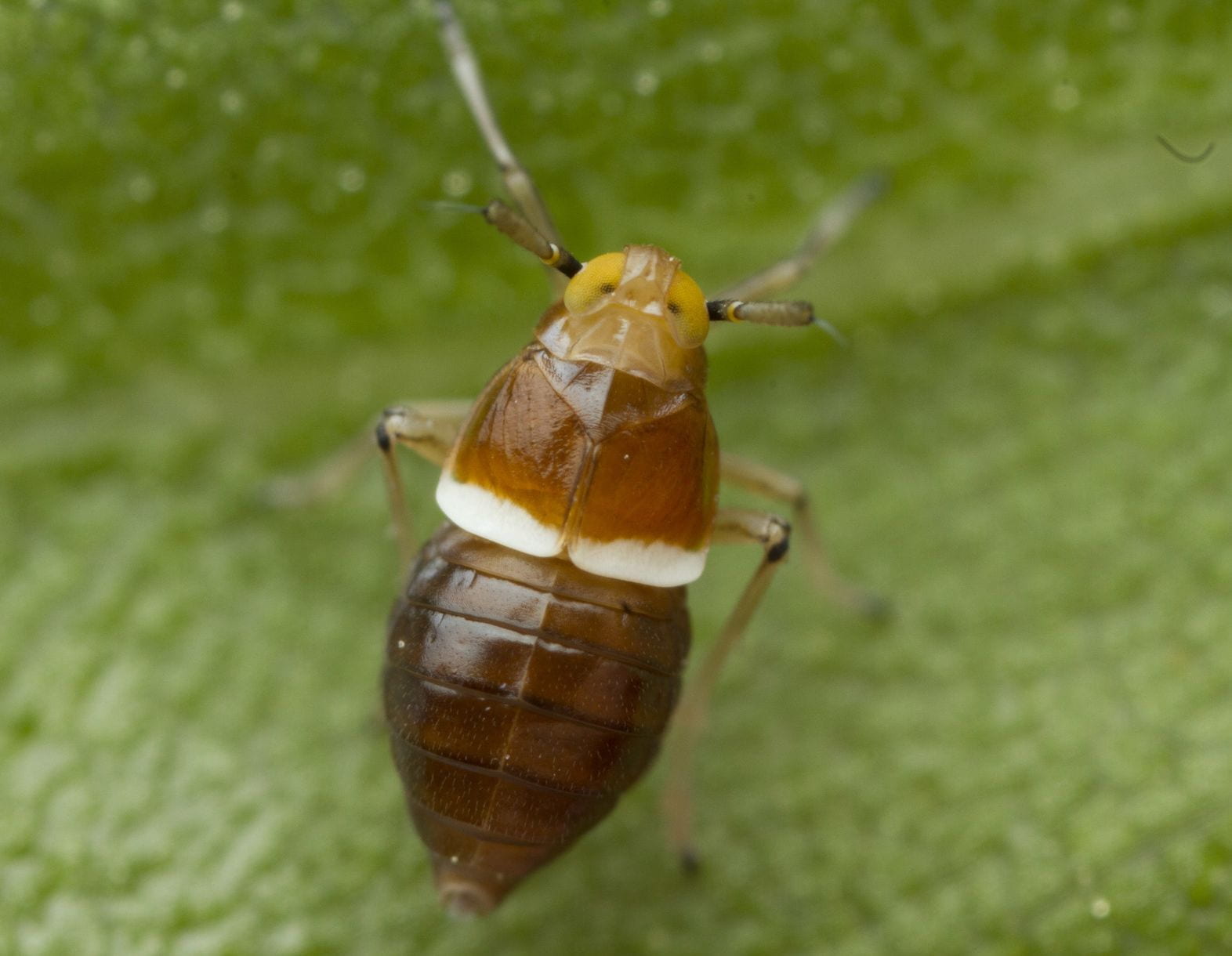
A Pissonotus from iNaturalist, likely- but not definitively – P. delicatus (Thomas Barbin, Goldstream Provincial Park, Victoria, BC, Canada)
Pissonotus flabellatus
Pissonotus piceus (Van Duzee) (This species varies considerably in shade from pitch-colored to orangish. Markings on the apex of the wing and posterior margin of the pronotum may be present or absent, but are generally narrow. The frons is usually dark dorsally and pale ventrally, but the colors intergrade, and sometimes the frons is entirely pale. The vertex is narrow compared with other Pissonotus and projects slightly forward. Also the calcar is relatively large [reminiscent of Megamelus], probably to assist with jumping off the surface of the water.)
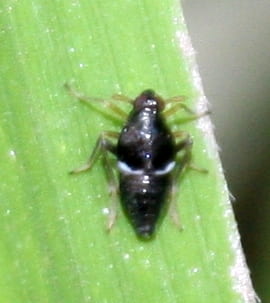
Pissonotus piceus in Baltimore City from Maryland Biodiversity.
Pissonotus piceus
Pissonotus quadripustulatus
Relative abundance
Out of curiosity, I extracted Pissonotus records out of the Tri-Trophic TCN database (a project I was part of) and iDigBio and found the number of records for each species as a way to get at how commonly encountered species are (the iDigBio data has some jr syns and species now excluded from Pissonotus, but I have presented it all, nonetheless. The most obvious biases of these data are that most of the collections that actually databased planthoppers in the Tri-Trophic TCN were eastern (which is probably why delicatus is not the most abundant species, and why frontalis is not better represented), and the project emphasized collections from North America, so tropical species are underrepresented. The iDigBio data should include all the Tri-Trophic TCN data, but it clearly does not.
| Row Labels | iDigBio | Tri Trophic TCN |
| binotatus | 577 | 578 |
| piceus | 489 | 524 |
| brunneus | 382 | 405 |
| delicatus | 283 | 276 |
| albovenosus | 186 | 174 |
| marginatus | 103 | 136 |
| flabellatus | 101 | 103 |
| quadripustulatus | 95 | 103 |
| dorsalis | 73 | 61 |
| albivultus | 54 | 30 |
| basalis | 41 | 42 |
| guttatus | 40 | 42 |
| divergens | 36 | 204 |
| niger | 17 | 17 |
| sp. | 15 | 98 |
| aphidioides | 13 | 13 |
| dentatus | 10 | 10 |
| paludosus | 10 | 12 |
| frontalis | 9 | 5 |
| melanurus | 8 | 8 |
| nitens | 7 | 6 |
| aquilonius | 6 | 6 |
| tumidus | 6 | 6 |
| jamaicensis | 5 | 0 |
| tessellatus | 5 | 4 |
| agrestis | 4 | 3 |
| concolor | 4 | 4 |
| lactofascius | 4 | 3 |
| nigriculus | 4 | 3 |
| rubrilatus | 4 | 5 |
| spooneri | 4 | 3 |
| merides | 3 | 2 |
| spatulatus | 3 | 3 |
| canadensis | 2 | 2 |
| decussatus | 2 | 1 |
| fulvus (jr syn of piceus) | 2 | 0 |
| minutus | 2 | 2 |
| muiri | 2 | 14 |
| radiolus | 2 | 2 |
| ater (jr syn of marginatus) | 1 | 0 |
| belemensis (now in Euides) | 1 | 0 |
| boliviensis | 1 | 0 |
| brazilensis (now in Euides) | 1 | 0 |
| crawfordi (jr syn of basalis) | 1 | 0 |
| divaricatus (jr syn of brunneus) | 1 | 0 |
| equadorensis (now in Euides) | 1 | 0 |
| megalostylus (now in Euides) | 1 | 0 |
| paraguayensis | 1 | 0 |
| pylaon (now Terthron) | 1 | 0 |
| speciosus (a jr syn of Flavoclypeus andromedus) | 1 | 0 |
| striolus (a jr syn of Euides fasciatella) | 1 | 0 |
| abdominalis | 0 | 7 |
| brevistilus | 0 | 1 |
| festucae | 0 | 1 |
| neotropicus | 0 | 1 |
Collecting
Most species are collected by sweeping or vacuum sampling their host plants. A few species come to lights, but usually not in abundance.
Online resources
TaxonPages.
iNaturalist.
FLOW.
Discover Life.
Bugguide.
Tom Murray pbase.
Wikipedia (stub with links).
GBIF.
EOL.
BOLD.
Hoppers of North Carolina. (Link arbitrarily to P. piceus)
Texas planthoppers.
Big Thicket east Texas.
IPM images.
Les Hémiptères du Québec.
Flickr (search = Pissonotus)
Maryland Diversity Project.
Molecular resources
At this time (8 Aug. 2018), Genbank has at least some data for ~8 species. Bold has specimen records of about 18 species (but not data for all of them).
Selected References
Ball, E.D. 1903. Some new North American Homoptera. Canadian Entomologist 35: 227–232.
Ball, E.D. 1926. The genus Phyllodinus and its allies (Homoptera: Fulgoridae) including the description of the new genus and species. Florida Entomologist. 10(2): 17–20.
Bartlett, C.R. & L.L. Deitz. 2000. Revision of the New World delphacid planthopper genus Pissonotus (Hemiptera: Fulgoroidea). Thomas Say Publications in Entomology: Monographs.
Bartlett, C.R. & G. Kunz. 2015. A new genus and species of delphacid planthopper (Hemiptera: Fulgoroidea: Delphacidae) from Central America with a preliminary regional species list. Zootaxa 3946(4): 510–518.(Erratum Zootaxa 3963(4): 598–600).
Bartlett, C.R., L.B. O’Brien & S.W. Wilson. 2014. A review of the planthoppers (Hemiptera: Fulgoroidea) of the United States. Memoirs of the American Entomological Society 50: 1–287.
Beamer, R.H. 1952. One old and five new species of delphacine fulgorids (Homoptera: Fulgoridae). Journal of the Kansas Entomological Society 25(3): 111–115.
Bossert, A.J. 2011. Comparison of the life histories of two dicot-feeding Pissonotus planthoppers (Hemiptera: Delphacidae). University of Central Missouri, Warrensburg, Missouri. Master’s Thesis.
Britton, W.E. 1923. Guide to the insects of Connecticut. Part IV. The Hemiptera or sucking insects of Connecticut. Bulletin. State of Connecticut. State Geological and Natural History Survey. 34:1-807. Fig(s).: 1–169. Plate(s): 1-20. [Pissonotus begins P. 48.]
Caldwell, J.S. & L.F. Martorell. 1951. [dated 1950]. Review of the Auchenorynchous [sic] Homoptera of Puerto Rico. Part II. The Fulgoroidea except Kinnaridae. Journal of Agriculture of the University of Puerto Rico 34(2): 133–269.
Crawford, D.L. 1914. A contribution toward a monograph of the homopterous insects of the family Delphacidae of North and South America. Proceedings of the United States National Museum 46: 557–640, plus 6 plates.
Fennah, R.G. 1959. Delphacidae from the Lesser Antilles (Homoptera: Fulgoroidea). Bulletin of the British Museum (Natural History). Entomology 8: 245–265. [see p. 255]
Fennah, R.G. 1967. Fulgoridae of the Galápagos Archipelago. Proceedings of the California Academy of Science, fourth series 35(4): 53–102.
Frison, T.H. 1927. A list of the insect types in the collections of the Illinois State Natural History Survey and the University of Illinois. Bulletin of the Illinois State Natural History Survey 16: 137–309. [see p. 152–-154]
Gibson, A. 1910. Entomological record, 1909. Annual Report of the Entomological Society of Ontario 40: 110–128. [record of Pissonotus marginatus]
Gibson, A. 1912. The entomological record, 1911. Annual Report of the Entomological Society of Ontario 36: 89–114. [Pissonotus marfinatus, P. ater]
Halbert, S. E. 2016. Entomology section. Pp. 6-14. In: T. E. Smith (Director). Tri-ology (October-December 2016) 55(4). 21 pp. [p. 7 [Halbert, S.E. & C.R. Bartlett. Pissonotus muiri, a delphacid planthopper, a new Continental USA record] pdf
Leach, W. E. 1815. Entomology. The Edinburg encyclopedia; conducted by David Brewster 9: 57–172. (family Delphacidae here).
Maw, H.E.L., R.G. Foottit & K.G.A. Hamilton. 2000. Checklist of the Hemiptera of Canada and Alaska, NRC Research Press, Ottawa, Canada.
Metcalf, Z.P. 1923. A key to the Fulgoridae of eastern North America. Journal of the Elisha Mitchell Scientific Society 38: 139–230. [e.g. p. 148]
Metcalf, Z.P. 1943. General catalogue of the Hemiptera. Fasc. IV. Fulgoroidea, Part 3. Araeopidae (Delphacidae), Smith College, Northampton, Massachusetts. 552 pp. [see p. 267]
Morgan, L.W. & R.H. Beamer. 1949. A revision of three genera of delphacine fulgorids from America north of Mexico. Journal of the Kansas Entomological Society 22(3-4): 97–142. JSTOR (97-120) (121-142)
de Motschulsky, V. 1863. Essai d’un catalogues des insectes de l’île Ceylan. Bulletin de la Société Impériale des Naturalistes de Moscou 36: 1–153.
Moya-Raygoza, G., E.L. Albarracin & E. G. Virla. 2012. Diversity of egg parasitoids attacking Dalbulus maidis (Hemiptera: Cicadellidae) populations at low and high elevation sites in Mexico and Argentina. Florida Entomologist 95: 105–112. https://doi.org/10.1653/024.095.0117 {Genus noted as a host of Anagrus flaveolus]
Muir, F.A.G. 1926. Contributions to our knowledge of South American Fulgoroidea (Homoptera), Part I. The family Delphacidae. Report of work of the Experiment Station of the Hawaiian Sugar Planters’ Association. Division of Entomology bulletin. 18: 1–51.
Muir, F.A.G. 1929. New and little-known South American Delphacidae (Homoptera, Fulgoroidea) in the collection of the British Museum. Annals and Magazine of Natural History (Ser. 10) 3: 75-85.
Muir, F.A.G. & W.M. Giffard. 1924. Studies in North American Delphacidae. Bulletin of the Hawaiian Sugar Planters’ Association Division of Entomology 15: 1–53.
Oman, P.W. 1947. The types of Auchenorrhynchous Homoptera in the Iowa State College Collection. Iowa State College Journal of Science 21: 161–228.
Osborn, H. 1935. Insects of Porto Rico and the Virgin Islands. Homoptera (excepting the Sternorhynchi). Scientific Survey of Porto Rico and the Virgin Islands 14: 111–260.
Osborn, H. 1938. The Fulgoridae of Ohio. Bulletin of the Ohio Biological Survey, Number 35. 6: 283–349.
Remes-Lenicov, A.M.M. de, A.C. Faltlhauser, A. Foieri, N.A. Salinas, M.C. Hernández & A.J. Sosa. 2024. New morphological and biological contributions to adults and immature forms of Pissonotus paraguayensis (Fulgoromorpha, Delphacidae) in wetlands of Argentina. ZooKeys 1188: 227; 1–24. https://doi.org/10.3897/zookeys.1188.113350.
Siwanowicz, I. & M. Burrows. 2017. Three dimensional reconstruction of energy stores for jumping in planthoppers and froghoppers from confocal laser scanning microscopy. Elife 6: doi: 10.7554/eLife.23824. [Pissonotus sp. noted]
Smith, J.B. 1910. Order Homoptera. Pp. 87-130. In: A report of the insects of New Jersey. Annual Report of the New Jersey State Museum 1909: 1–888. (PDF only to end of Auchenorrhyncha, p. 107; see link to BHL for whole volume) (see pp. 94-98)
Spooner, C. S. 1912. Some new species of Delphacidae. Canadian Entomologist 44: 233-242.
Stiling, P.D. 1994. Coastal insect herbivore populations are strongly influenced by environmental variation. Ecological Entomology 19(1): 39–44.
Strickland, E.H. 1940. Additional Fulgoridae taken in Alberta. Canadian Entomologist 72(4): 87-88.
Van Duzee, E.P. 1894. Megamelus piceus n. sp. Pp. 28–29. In: G.C. Davis. Celery insects. Bulletin of the Michigan State Agricultural College Experiment Station 102: 1–32.
Van Duzee, E.P. 1894e. A list of the Hemiptera of Buffalo and Vicinity. Bulletin of the Buffalo Society of Natural Science 5(4): 167–204 . [see p. 189–193]
Van Duzee, E.P. 1897. A Preliminary Review of the North American Delphacidae. Bulletin of the Buffalo Society of Natural Sciences 5(5): 225–261.
Van Duzee, E.P. 1907. Notes on Jamaican Hemiptera: A report on a collection of Hemiptera made on the island of Jamaica in the spring of 1906. Bulletin of the Buffalo Society of Natural Sciences 8(5): 3–79. [Pissonotus on p. 44]
Van Duzee, E.P. 1909. Observations on some Hemiptera taken in Florida in the spring of 1908. Bulletin of the Buffalo Society of Natural Sciences. 9: 149-230.
Van Duzee, E.P. 1909c. Synonymical notes on North American Homoptera. Canadian Entomologist 41(11): 380–384. (poor copy) [Pissonotus noted]
Van Duzee, E.P. 1916. Suborder Homoptera Latr. 1810. Section Auchenorhyncha A. & S. 1843. In Check list of Hemiptera (excepting the Aphididae, Aleurodidae and Coccidae) of America north of Mexico. New York Entomological Society, New York. pp.: i-xi, 1–111.
Van Duzee, E.P. 1917a. Report upon a collection of Hemiptera made by Walter M. Giffard in 1916 and 1917, chiefly in California. Proceedings of the California Academy of Sciences (4) 7: 249-318.
Van Duzee, E.P. 1917b. Catalogue of the Hemiptera of America north of Mexico excepting the Aphididae, Coccidae and Aleurodidae. Technical Bulletin. University of California, College of Agriculture, Agricultural Experiment Station. Entomology. 2: i-xiv, 1-902.
Van Duzee, E.P. 1925. New Hemiptera from western North America. Proceedings of the California Academy of Sciences (series 4) 14: 391-425.
Walker, F. 1851. List of the specimens of Homopterous Insects in the collection of the British Museum. British Museum, London. 2: 261–636, 3: 637–907.
Wheeler, A.G. jr. & E.R. Hoebeke. 2008. Conomelus anceps (Germar) (Hemiptera: Fulgoromorpha: Delphacidae) new to North America, with records of four other delphacid planthoppers new to Newfoundland. Proceedings of the Entomological Society of Washington 110(2): 265–283.
Webb, D.W. 1980. Primary insect types in the Illinois Natural History Survey collection, exclusive of the Collembola and Thysanoptera. Illinois Natural History Survey Bulletin 32: 55–191.[Fulgoridae begins p. 86]
Wilson, S.W. & J.H. Tsai. 1991. Descriptions of nymphs of the Delphacid planthopper Pissonotus delicatus (Homoptera: Fulgoroidea). Journal of the New York Entomological Society 99(2): 242–247.
Wilson, S.W. & J.E. McPherson. 1980a. Keys to the planthoppers, or Fulgoroidea, of Illinois (Homoptera). Transactions of the Illinois Academy of Science 73(2): 1–61.
Wilson, S.W. & J.E. McPherson. 1980b. The distribution of the Fulgoroidea of the eastern United States (Homoptera). Transactions of the Illinois Academy of Science 73(4): 7–20.
Wilson, S.W. & J.E. McPherson. 1980c. A list of the Fulgoroidea (Homoptera) of southern Illinois. Great Lakes Entomologist 13(1): 25-30.
Wilson S.W. & A.G. Wheeler. 2010. Planthopper (Hemiptera: Fulgoroidea) diversity of weeping lovegrass (Eragrostis curvula), an introduced host of little-known, rarely collected native species. Entomologica Americana 116(3): 98-106.
Wilson, S.W., C. Mitter, R.F. Denno & M.R. Wilson. 1994. Evolutionary patterns of host plant use by delphacid planthoppers and their relatives. In: R.F. Denno & T.J. Perfect (eds.). Planthoppers: Their Ecology and Management. Chapman and Hall, New York. Pp. 7–45 & Appendix.
Wirtner, P.M. 1904. A preliminary list of the Hemiptera of western Pennsylvania. Annals of the Carnegie Museum. 3:183–232.



